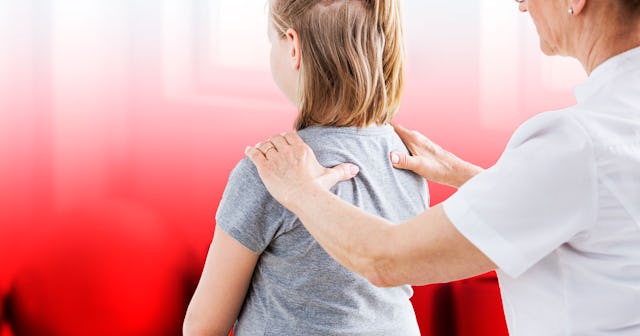I Was Diagnosed With Scoliosis As A Kid — Here's What Parents Need To Know

Scoliosis. For many, it’s a scary word. Why? Because the first time most parents and children hear it is in a medical setting. I was diagnosed with scoliosis in 1997, when my cardiologist noticed a curve in my neck — the first of two curves an orthopedist would find. But what is scoliosis, and more specifically, how does it affect teens and adolescents?
Here’s everything parents need to know about this common medical condition.
What is scoliosis?
Scoliosis is a common medical condition, one which affects millions each year. According to Kids Health, patients with scoliosis have a curvature in their backbone. Instead of forming a straight line, the spine rotates or twists, and depending on the severity of the deformity, medical problems can occur.
What are the symptoms?
Most individuals with scoliosis do not know they have it. The condition causes very few symptoms. However, some individuals will experience a dull to minor ache in their back or neck. According to the Mayo Clinic, symptoms may include shoulders that are not even, an uneven waist, having one hip that is higher than the other, or one shoulder blade that protrudes more than the other.
What causes scoliosis?
The exact cause of scoliosis is unclear. In fact, according to the Mayo Clinic, doctors don’t know how the deformity originates. However, genetics may play a role. “When parents hear scoliosis runs in families, they often say, ‘But nobody in our family has it,’” Paul Sponseller — a pediatric orthopedic expert and the director of the Johns Hopkins Division of Pediatric Orthopaedic Surgery — tells John Hopkins Medicine. “But in reality, it’s likely that someone does or did and it went unnoticed because it was a very mild case.”
Is there any way to prevent it?
KatarzynaBialasiewicz/Getty
Since doctors do not know what causes scoliosis, there is (unfortunately) no way to prevent it. However, it’s important for parents to realize that it’s not their fault if their child is diagnosed with scoliosis. “Parents tend to ask what they could have done to prevent scoliosis,” Sponseller says. “But scoliosis is a very interesting disease because there is currently no known cause or prevention method.”
How is this condition diagnosed?
While there are several ways scoliosis can be diagnosed, most cases are first noticed during a common pediatric exam known as the Adams forward bending test, or the Adams exam. During this test, patients may be instructed to take off their shirt so that the spine is visible. Patients are then directed to bend forward, starting at the waist. Practitioners then analyze the spine for abnormalities, or curves.
If scoliosis is suspected, a series of X-rays will be ordered to confirm the severity of the curve[s] or condition. An MRI may also be arranged, particularly if and when an underlying cause is suspected and/or for children who need surgery.
How is scoliosis treated?
The treatment for scoliosis varies from person to person (and patient to patient), but most cases of scoliosis require little to no medical intervention. According to Raising Kids — an Australian-based parenting website — children with mild scoliosis simply need monitoring and oversight. Doctors usually recommend X-rays every four to six months. Patients with moderate scoliosis may need physical therapy and/or a brace, and patients with severe scoliosis could require surgery. However, this is rarely recommended.
“I see a number of patients who automatically assume they will need treatment for their scoliosis, but only a small percentage — about 30 percent — require bracing, and an even smaller percent — about 10 percent — of patients actually require surgery,” Sponseller assures. “Scoliosis is a very manageable condition,” he adds, especially when diagnosed early.
That said, regardless of when the condition is diagnosed and/or the treatment plan, it’s important to note the outlook for scoliosis patients is good. I had surgery in 1999 — there is a rod and five screws in my spine — and I am in peak physical shape. I lift weights, do yoga, and run marathons. My limitations are few. And most patients are the same.
“Learning your child has scoliosis is a tough concept to wrap your mind around. You might feel worried that their condition will make them feel different from your peers, or you may wonder if your child be able to do the same activities other kids do,” an article on Spine Universe explains. But “with an early diagnosis and a supportive network of family and friends, your child will find that scoliosis won’t come between him/her and the life they want to live.”
This article was originally published on